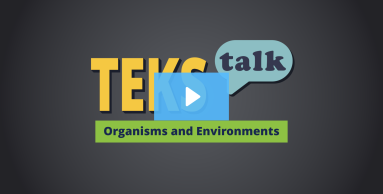- Science
- Grade 2
- Organisms and environments

Knowledge and Skills Statement
Give students a reading that describes how organisms depend on each other within a specific ecosystem. Ask each student to identify the producers in the article. Students should be able to identify plants as producers. Then ask students to identify one consumer that eats their selected producer. For example, if the student identified grass as the producer in a prairie, they should then identify something like a rabbit or a grasshopper as a consumer who eats grass. Then ask students to identify a second consumer that eats the first consumer they identified. In the prairie example, students might identify a hawk as a consumer of rabbits or a blue jay as a consumer of grasshoppers. Ask students to explain the relationship and energy flow between at least three organisms in the reading by drawing a food chain and writing one or two sentences correctly using the words producer and consumer.
The further explanation is designed to be a resource for educators that helps them better understand the topic their students are learning. Further explanations may be written at a more complex level than would be expected for students at the grade level.
An example of a food chain in words and in images is provided below
A food chain arranges the organisms in an ecological community according to the order of predation in which each uses the previous member as a food source; may include producers, herbivores, omnivores, and carnivores. As an educator, it is important to know that herbivores, omnivores, and carnivores are all referred to as consumers at this grade level.
Image Attributions/Location:
Grass: Grass icons created by Iconriver - Flaticon
Grasshopper: Grasshopper icons created by BZZRINCANTATION - Flaticon
Research
Keeley, Page. “Formative Assessment Probes: No More Plants: Uncovering Students’ Ideas About Interdependency and Change.” Science and Children 52, no. 8 (2015): 24–25. http://www.jstor.org/stable/43501048.
Summary: There are several common misconceptions that students make about interdependency and food chains. Students may assume that only the next living thing in a food chain is affected if one organism dies off, not realizing how this would affect the entire food chain. This article explains that early childhood students should understand that all animals depend on plants, even animals that do not eat plants at all. Students need to realize that all animals depend on plants, as in their later grades, they will need to understand that plants are the primary source of energy for animals in food webs. When teaching food chains, teachers should repeatedly trace back to plants at the start of the food chain and ask students other questions about interdependency in an ecosystem.

